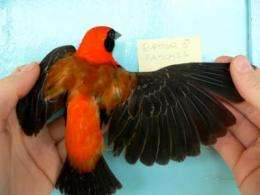Plumage-color traits more extreme over time

Ever since Darwin, researchers have tried to explain the enormous diversity of plumage colour traits in birds. Now researchers at the University of Gothenburg, Sweden, are adding something new to this particular field of research, which is so rich in tradition, by demonstrating how a bird can become red instead of yellow.
Sixteen years ago, Malte Andersson, a professor at the University of Gothenburg, published the book Sexual Selection, which analysed how animals use behavioural signals, colours and other ornamentation to compete for a mate. Based on, among other things, a famous experiment involving a long-tailed widowbird published in Nature in 1982, and is now a standard zoological work that has been cited in around 5,000 scientific articles and innumerable textbooks.
The third generation of ecological researchers at the Department of Zoology at the University of Gothenburg are now publishing their findings in this field. Together with colleagues and project leader Staffan Andersson, postgraduate student Maria Prager has studied how sexual signals in widowbirds and bishops (Euplectes spp.) are produced and change during the evolutionary process.
In the past, the function of signals was much disputed but is now well-known: it has to do with attracting a mate for reproduction and deterring rivals. But why the animal kingdom displays such an enormous range of signals and traits has still not been explained. The African widowbirds and bishops are an excellent illustration of this phenomenon: despite being closely related and using classic avian signals - elongated tail feathers and bright colours - there is a fascinating amount of variation in the traits of these species.
Maria Prager's thesis follows on from field studies that indicate a general pattern amongst these and many other birds: females prefer males with the longest tail feathers, while males with larger and redder colour signals are able to occupy larger breeding territories. Maria Prager's hypothesis was that the signals of widowbirds and bishops thus have become ever more extreme during evolution.
A lack of fossil feathers means she has studied modern DNA in order to reconstruct the evolution of colours and plumage in the genealogical trees of these species. The results show that today's species of widowbirds and bishops are descended from birds with short tails and yellow colour signals.
The current red colour has evolved through several means: the birds store large amounts of yellow dietary pigments in their feathers, which produce a red hue, or they convert some of the dietary yellow pigment to red with the aid of an enzyme. As yellow widowbirds and bishops seem to lack this enzyme, colour diversification may be due in part to physiological or genetic limitations in some species.
Malte Andersson was a pioneer in work to test and further develop Darwin's concept that the reproductive success of males often depends on eye-catching ornamentation. Maria Prager's research now clarifies three new aspects of colour signalling: the pigment mechanisms behind colours, the development of colours in individuals, and the evolution of colour signals over time.
"Our combined research provides a unique and complete picture of colour evolution in birds, and there are few other animals for which we now have so much knowledge of the various aspects of these signals."
Provided by University of Gothenburg


















